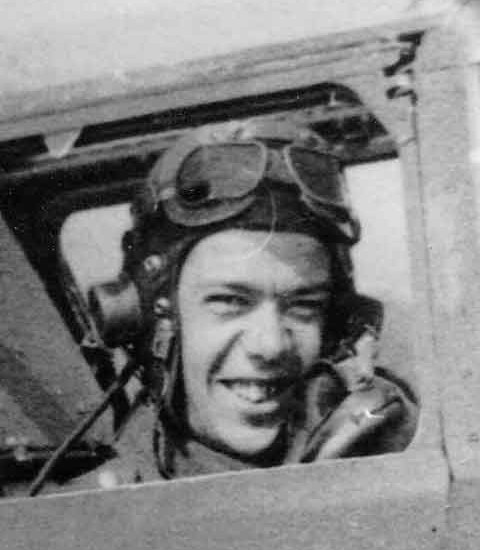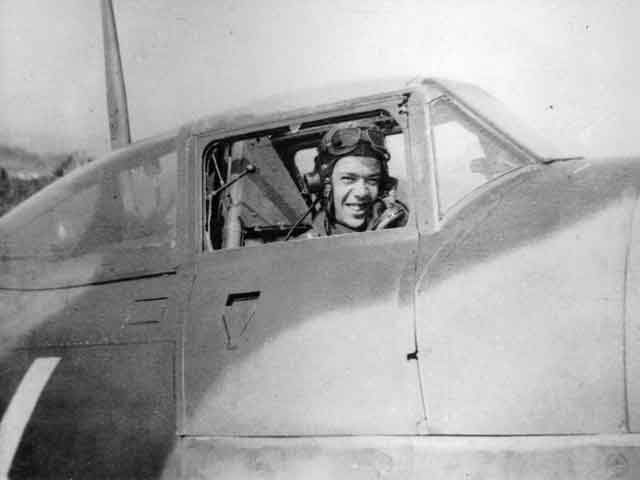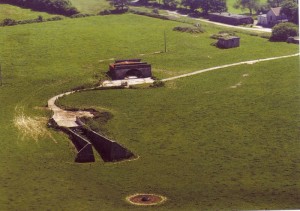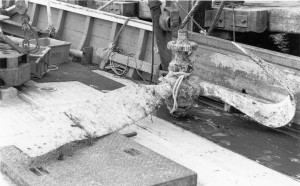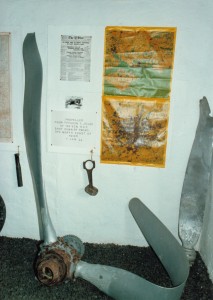CRABB, John Malcolm
- 24 years
- United Kingdom
- Flight Lieutenant
- 84967
- Typhoon Ib, JR436
- 7th January 1944
- North of Herm
- Allied Aircrew Memorial, Guernsey
Crabb served with several units and he is know to have flown with A flight of No. 3 Squadron. It is unclear when he joined this squadron, but we know that he was part of this unit it being confirmed by a report dated 2 March 1941, when at 1445 hrs he was flying a Hawker Hurricane over the sea about 30 miles off Sumbergh, Scotland, when he encountered a large enemy aircraft. Crabb takes up the story himself: I was flying as Red 1, at 1435 hours when flying at ten feet over the sea I sighted a F.W. 200 at a similar height about 5 miles ahead flying on the same course at approximately 220 miles per hour, I closed to 600 yards and fired two four second bursts, from dead astern, braking off at 150 yards. Heavy return fire from a machine gun was experienced at first but then ceased abruptly and no further fire was experienced from the rear gun. I then climbed away to right and attempted to overtake the enemy aircraft, then flying at approximately 270 mph. I delivered a beam attack diving from 500 feet directly to starboard firing one three-second burst from 200 to 30 yards, passing above and slightly behind the enemy aircraft. I delivered a similar attack from the port beam. No return fire was noticed on either attack. Having run out of ammunition I made a dummy attack from the starboard front, endeavouring to force the enemy aircraft down into the sea. Considerable return fire was experienced from front guns. I then broke away and returned to base with Red 2, landing at Sumburgh at 1500 hours.
The report concludes that due to the fact that tracer was seen to enter the fuselage of the Focke Wulf 200 Condor, it was presumed that the rear gunner was killed and the aircraft badly damaged. Incidentally this attack is the first reported Allied engagement with a Focke Wulf 200 Condor. Following this on 7 September 1941 he was again promoted this time to Flying Officer. It is not known when Crabb left this squadron, but it is assumed to coincide with his arrival at No. 1 Squadron then based at Tangmere where he served from November 1941 to April 1942 again flying Hurricanes.
Dennis Burke supplied the following information:
“On July 25 1942, the Irish Army stationed in the Inishowen Peninsula in Donegal had to respond to a report of an aircraft having landed on the beach near Ballyliffen. It turned out that at 1830 hours that evening a single engined Royal Air Force Westland Lysander aircraft had made an emergency landing. The crew of two men reported they were flying from Valley in Angelsey, Wales saying they had lost their bearings and had been forced to land having only a half hour of fuel left.
The subsequent Irish Army Intelligence (G2) report, G2/X/1038, recorded the names of the crew as Flight Lieutenant J. Crabbe and Sergeant A. Fryer. No Christian names or service numbers were recorded in the report or at least don’t seem to have survived if they were. The aircraft, a Westland Lysander, a type operated by the Irish Air Corps at this time also, was recorded as such but no identifying marks were noted. What was recorded, however, were the next of kin addresses of the two men – Yeadon, Leeds for Crabb, and Coventry for Fryer.
The two airmen were accommodated over night in Fort Lenan with the Irish Army Garrison there. Additional fuel was delivered from Northern Ireland the next day and after refueling the Lysander and its airmen took off at 1330 hrs. The report records the crew as being ‘on a training flight’ thus giving the authorities the necessary free hand to allow the crew to depart and not be interned. “
Crabb was finally promoted to Flight Lieutenant on 7 September 1942. His wife Margaret joined the Woman’s Auxiliary Air Force in January 1943 and after the war remarried following her husbands wishes, should he be killed on active service.
The Royal Air Force had code words for most of their missions in WW2 and RAMROD was just one of twenty different types of raids so code-named. A RAMROD mission was, in simple terms, a short range attack to destroy ground targets, with the number being related directly to the number of planned or completed missions.
RAMROD 122 was a 10-Group mission planned as an operation with the intention of hitting a NO-BALL site at Le Mesnil au Val in France, which was located just to the south-east of the port Cherbourg. A ‘NO-BALL’ is yet another code word and relates to a mission against V-weapon launch sites or related installations. Le Mesnil au Val was a V1 rocket launch site where the launching ramp walls still exist. It was constructed and lined up to attack targets in the Bristol area of England. The date for the planned mission RAMROD 122 was Friday, 7 January 1944.
The attack was to be completed by 193 Squadron flying Hawker Typhoon fighter- bombers from their base at RAF Harrowbeer, Devon. The Hawker Typhoon (affectionately known as the ‘Tiffie’) was designed as a high-altitude interceptor, but it also proved to be an excellent low-altitude performer and later in the war was adapted to carry either 500-lb drop bombs or high-explosive rockets mounted under each wing.
The aircraft of 193 Squadron took off from their base at 0929 hrs and consisted of eight Hawker Typhoons (Mk 1b). They were flown by Flight Lieutenant John Crabb (flight leader), Flight Sergeant James McCartney, Flying Officer James W Darling, Flight Sergeant Norman Kenneth Bale, Flight Lieutenant Percy H Beake, Pilot Officer Phil G Murton, Flying Officer William A Switzer and Pilot Officer Ian Ross. This unit was known as Part 1 of Force 3. It had been realised in the planning stages that it was unlikely to be classed as a fully successful mission with just sixteen 500 lbs bombs being dropped on this NO-BALL site, so it was planned to use the same aircraft to hit the same target twice in the same day.
Naturally there would be obvious difficulties during the second attack, as the enemy was invariably pre-warned and was now prepared for an allied air-raid with the Flak fully manned. In addition, the defenders would have had the opportunity to scramble aircraft to intercept any further attacks on the target that day and the radar would be switched on and monitored closely.
The aircraft, flying the course as planned, found on arrival that the target was obscured by cloud but could see, further to the south, the Maupertuis Luftwaffe training airfield was clear. Maupertuis airfield is located north-east of Granville and only added a few minutes of flying time to the mission, so it was decided to bomb this new target. On arrival it was reported that many bomb bursts were seen in and near south-west aircraft dispersal area and two further bombs detonated in centre of airfield. However, there were no enemy aircraft seen on ground, although it was not a place to sit around and study as there was Intense medium Flak over the airfield with shells bursting at 5000 ft.
After the bombing which was completed from north to south, the aircraft turned left and then looped round and re-crossed the coast to the north west of Maupertuis, effectively running up the coast to the east of the Channel Islands. Heavy but inaccurate Flak was encountered from the Cherbourg area, but this caused no concern for the aircraft. Two vapour trails were seen at approx 25,000 to 30,000 ft well west of peninsula, going south, but no enemy aircraft were seen and it was further reported no shipping was seen in the area. The weather on that first part of the mission was reported as 10/10 (very poor visibility with thick cloud), with wispy cloud lower at 1000–2000 ft over area south-west of Cherbourg, but clear skies to the west over the Channel Islands. The aircraft all returned to base without incident and landed at 1107hrs to be refuelled and reloaded with bomb and ammunition.
It was now time to for Part 2 of Force 3 – this was again led by Flight Lieutenant John Crabb, he was accompanied by Pilot Officer Edwin ‘Ned’ Statters and Flight Sergeant Gus A Gough. Only three instead of the planned eight aircraft were available to take part and they formed as Blue section; this was largely because of a breakdown of bombing equipment. The time for departure is not recorded but it is suspected that is was about 1500 hrs. The aircraft flew west of Casquets lighthouse and were intending to have a go at the initial target, so were due to turn east towards the Cotentin Peninsula. Shortly after having started to climb towards the French coast Blue 2, Statters and Blue 3, Gough who were flying behind and either side of Blue 1, Crabb, saw part of Blue 1’s rudder being shot off, having been pounced on by Fw 190s. This was the last the report of Blue 1. Blue 2 and 3 broke right and left respectfully, jettisoned their bombs and turned for home. Blue 3, on breaking away, went into a spin and only just recovered near sea level. During the break away Blue 2 and Blue 3 counted at least two Fw 190s and assumed there was possibly more. When they levelled out again no enemy aircraft were visible, the Fw 190s having gone into cloud base which was at 2000 ft. The two remaining Typhoons turned north to base. No wreckage of Crabb’s aircraft or oil was seen in the water and the approximate position was estimated to be about two miles north-east of Guernsey.
We can now take up the story as recalled by local Guernsey diarist Ken Lewis who reports:
About 3.40 pm I heard the siren sound and saw planes overhead. I could not see anything when suddenly I heard shots like a machine gun from the north of Herm and saw flashes and spurts of water as if from small calibre shells. Shortly afterwards a plane came at high speed over the harbour and the light Flak fired about half a dozen shots, but nowhere near it, shortly after three more planes came, this time German BF109s and in my opinion the first was another British plane being chased and the gunners of the Flak held their fire knowing that German planes were in the chase.
Lewis concludes his report stating: Later I heard that a plane crashed to the north of Herm and it must have been the splash we saw. Many reports say it was a German plane.
Other local diarists report similar stories, but of course these were incorrect as it was a British plane being pursued by three Fw 190s which were from the Stab JG 2 NAG 13 (Short-range Reconaissance Wing 13); these aircraft were elements of Jagdgeschwader 2 (JG2), which were based at Cherbourg. The Jagdgeschwader 2 were often referred to as ‘Richthofen Squadron’ after the World War 1 German fighter ace Manfred von Richthofen. The aircraft predominantly employed by this unit was the Focke-Wulf Fw 190.
We do know that the pursuing aircraft were flown by Oberleutnant Gündel, Oberleutnant Klink and Oberfeldwebel Niense. They had shot down Crabb and were pursuing now another aircraft from 193 Squadron flown by Pilot Officer Statters, whose Typhoon was damaged. It fortunately landed safely in England and the damage was recorded as being Category B (Beyond repair on site, but repairable at a Maintenance Unit or at a contractor’s works). The action itself took place running down south from the Casquets and Crabb must have finally ditched just north of Herm.
On the arrival of the last two planes from Blue section, the loss of Crabb was reported and subsequently the unit dispatched six Typhoons of 193 Squadron on an air-sea rescue flight, taking off from their base at 1646 hrs to search for Crabb. The aircraft flew in a wide line-abreast search, to the north of Guernsey, flying east until five miles off the French coast, then changed direction heading north between Alderney and Cap de la Hague; the whole mission was flown at sea level, but nothing was seen. The aircraft landed at 1756 hrs.
Flight Lieutenant John ‘Johnny’ Malcolm Crabb was just 24 when he died, flying a Hawker Typhoon Mk. Ib. serial number JR436, his body was never recovered. He is remembered on the Allied Aircrew Memorial Guernsey.
Some years ago the remains of a propeller were raised from the seabed near Tautenay, a group of rocks about a mile due north of Herm. It consisted of 2 blades of the propeller and the airscrew hub. It was trawled up in 1978 by the Guernsey fishing vessel MORNE LASS, skippered at the time by Mr Ogier;
It was found at a depth of just sixty feet and got tangled in the fishing net. It was difficult to get it aboard due to the swell, but it was eventually managed and was later landed at St Peter Port. The matter was of course reported in the Guernsey Evening Press and a follow up report a few days later, mentioned that a Mr Bert Le Noury at the time of publication was a berthing attendant at Beaucette Marina, he claimed to have witnessed the dog-fight between the aircraft, stating:
I remember seeing bullets flickering between the two fighter aircraft, then one plummeted into the sea, narrowly missing my boat. I waited to see if the pilot would come to the surface, but he never did.
Mr Le Noury suggested he knew it was a British fighter because a chart produced in England floated to the surface shortly after, but he never saw anything more of the aircraft.
The remains of the propeller trawled up in 1978 now resides on permanent display at the German Occupation Museum, Forest. A close examination of the blade shows bullet strikes on the reverse face where the Fw 190’s machine-gun bullets hit as they pursued and shot down the Typhoon.





